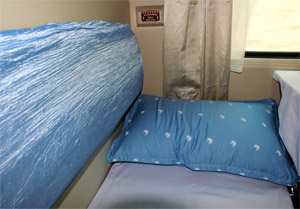Tibet Train Conditions
 One of the most prominent features of trains running on the Qinghai-Tibet railway is their capability to operate normally in the alpine hypoxia environment. The trains are specially equipped for highland travel with high altitude oxygen supply systems. Te technology automatically controls the oxygen content in the air in the train, so that air oxygen concentrations remain at a suitable level and helps passengers overcome altitude sickness. In addition, the railway uses sealed, oxygenated cars to deal with the thin air and high-tech cooling to keep the frozen track bed stable.
One of the most prominent features of trains running on the Qinghai-Tibet railway is their capability to operate normally in the alpine hypoxia environment. The trains are specially equipped for highland travel with high altitude oxygen supply systems. Te technology automatically controls the oxygen content in the air in the train, so that air oxygen concentrations remain at a suitable level and helps passengers overcome altitude sickness. In addition, the railway uses sealed, oxygenated cars to deal with the thin air and high-tech cooling to keep the frozen track bed stable.
Each train carriage has an oxygen system, fresh air monitoring system, garbage compression processor, automatic drinking machine, fire alarm, storage compartment, bedding room and emergency exit window. Each seat is equipped with an oxygen mask which can be used by individual passenger if needed.
In order to protect the ecological environment of Tibetan plateau, the all waste including sewerage and waste water is collected for disposal safely. All railway cars are equipped with double-layer glass which is covered with anti-ultraviolet radiation film.
The train is also equipped with special toilets for the disabled.
Each compartment has a power charging socket. The trains can run at a speed of 120 kilometers in the non-frozen area and 80 kilometers in the frozen track area.
Signs are usually displayed in Chinese, Tibetan and English.
The trains can run at a speed of 120 kilometers on the non-frozen area and 80 kilometers in the frozen track area.
Staffs on the trains
All staffs on the trains have a basic knowledge of altitude sickness and can speak some English.
Xining to Tibet Train travle only from $969